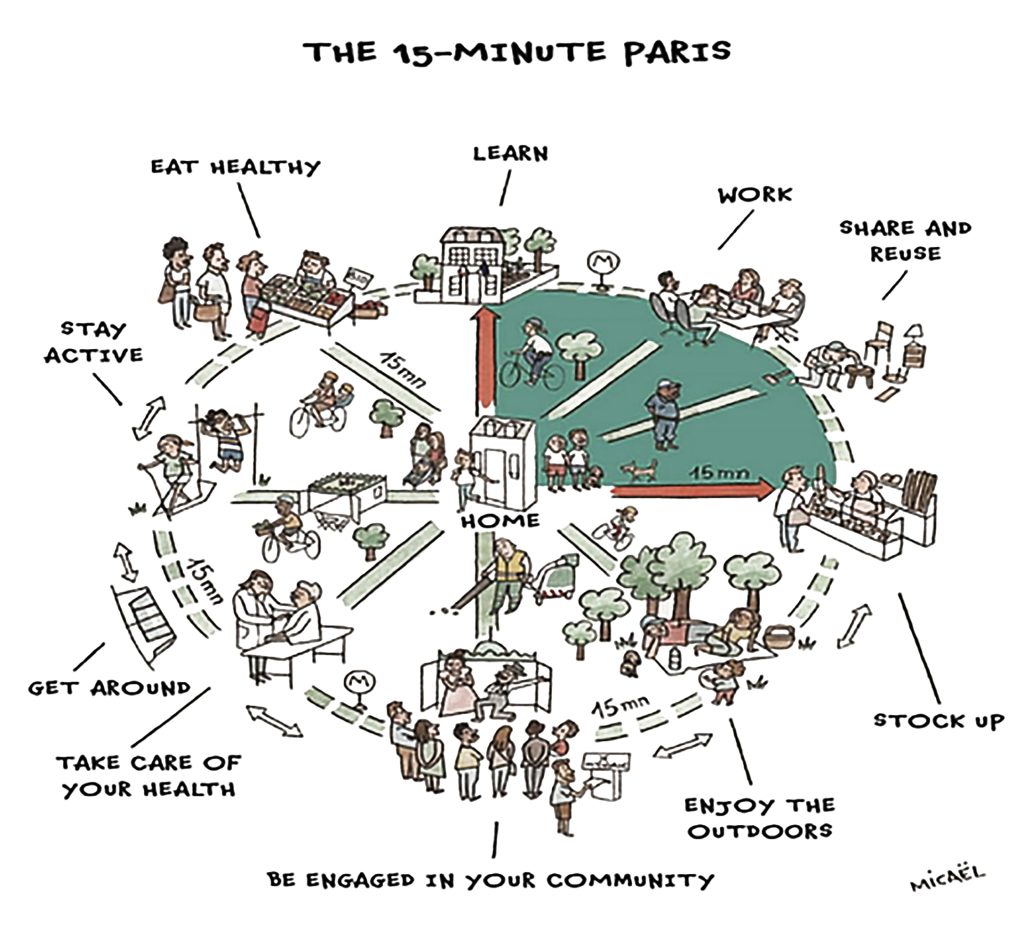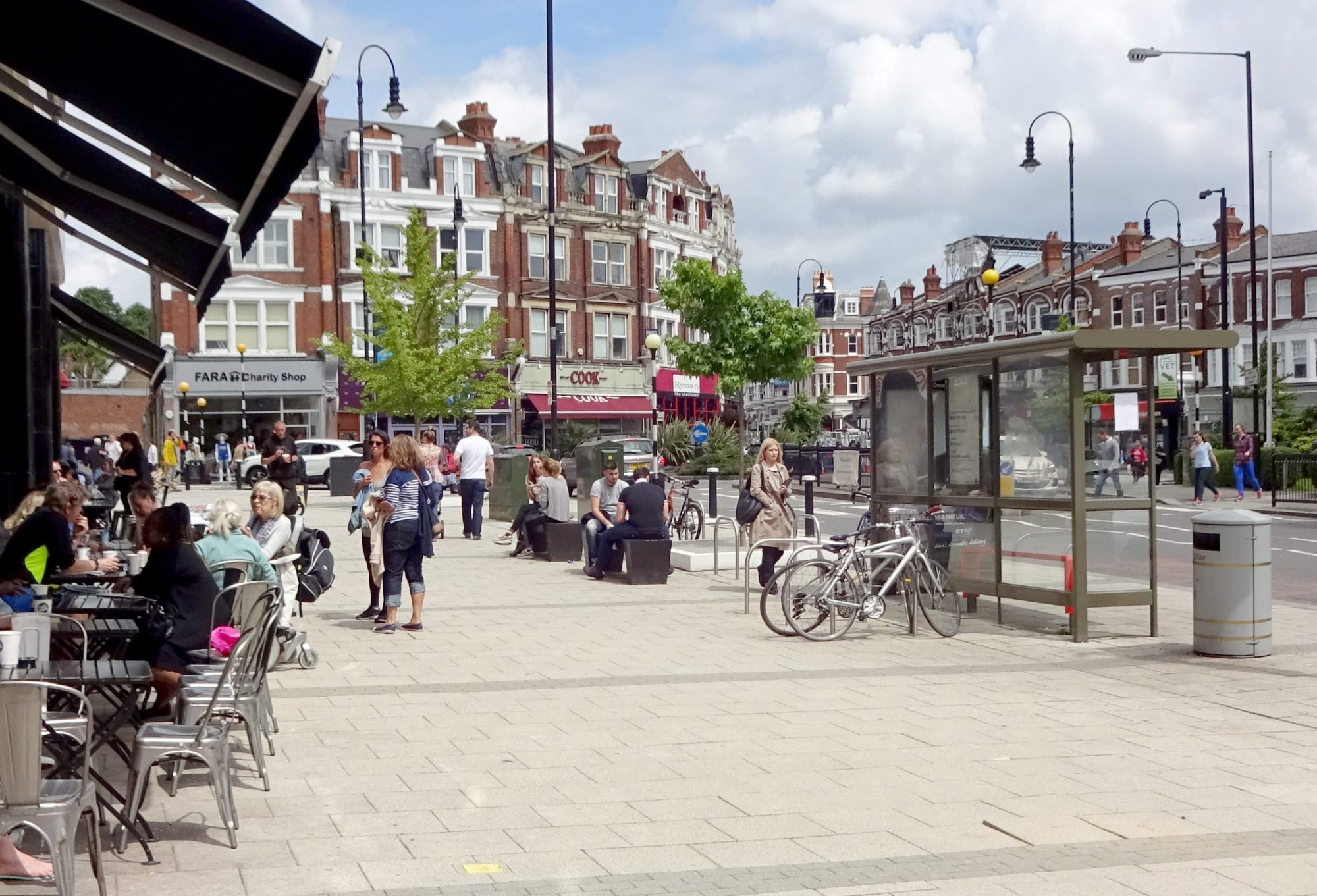The 15-minute city has found itself embroiled in conspiracy theories and even angry protests. PBC Today asked David Edwards of Placemake to unpack the myths and reality around the idea
Full disclosure from the outset: before writing this, my understanding of the 15-minute city was limited. From what I had heard and read, I assumed it to be a hybrid of existing ideas, principally compact cities, transit-orientated development and localism coupled with the general good practice of planning around walking distances.
Once it broke into mainstream media, I knew I had to investigate further but then the conspiracy theories began circulating and suddenly it was no longer a new way of living but a mechanism for civil repression.
When an associate in the Middle East recently said they had read that UK residents would be required to wear GPS devices to monitor and constrain their movement beyond city limits, the notion seemed so bizarre that I could dismiss it all as a passing trend without ever really knowing the crux of the discussion.
For some reason, PBC Today seemed to think this would be a healthy outlook for a balanced review, thereby prompting a deep dive into a notion that I was probably too quick to judge from the outset.
So, what is the 15-minute city all about?
In 2021, Professor Carlos Moreno of the Pantheon Sorbonne University in Paris, won the Obel Award for his concept of La Ville Du Quart d’Heure. For Professor Moreno, today’s cities are built around travel by car, thereby encouraging decentralisation and urban sprawl. However, the 15-minute city represents the reversal of this trend to focus on a human scale and micro-mobility.
In this model, all of the activities that a person needs to dwell – work, shopping, leisure, education, health and entertainment are located within a 15-minute walk of their home. According to Professor Moreno in a 2020 TED talk, there are four guiding principles:
- Ecology: A green and sustainable city.
- Proximity: Reduced distances to other activities.
- Solidarity: Creating links between people.
- Participation: Encouraging residents to shape their own environment.
He emphasises the objective is not to de-urbanise the city; rather, to restructure it around the needs and wellbeing of its residents. To achieve this, there are three key features:
- The rhythm follows humans and not cars.
- Every space is used efficiently.
- It is designed for residents to live, work and thrive without needing to travel.
The judging panel for the Obel Award determined: “The 15-minute city is an intuitive concept and has the capacity to deliver tangible change in people’s lives… [it is] an ambitious and complex urban strategy – but also a refreshingly pragmatic approach.”
It is assumed that 15-minutes was selected as this represents a healthy walk at a brisk pace, amounting to approximately 2,000 steps or approximately 2km. Thus, four 15-minute walks per day would achieve the total of 10,000 steps that many of our counters are set to but rarely reach.
Professor Moreno’s evolving concept received significant validation when in 2020, the mayor of Paris announced that it would be adopted to lead the “ecological transformation” of the French capital, gradually phasing-out traffic and congestion to “improve overall quality of life for residents and visitors”.
Will the 15-minute city concept work?
Many towns and cities have naturally evolved around walking and riding distances and are already operating as 15-minute cities. For instance, a journey from the south side to the north side of Edinburgh involves passing through the neighbourhoods of Leith, Newhaven, Stockbridge, Haymarket, Tollcross, Marchmont and Morningside.
Each are located between 1.5km and 2km apart and have their own characteristics and identity. While in London, the distance between Northern Line tube stations from Camden Town (Zone Two) to High Barnet (Zone Five) is generally between 1km and 2km. In both of these examples, the spacing between existing hubs equates to broadly the radius of the 15-minute city.
Indeed, catchment areas and walking distances already form a core part of land use zoning in the UK and internationally, while Professor Moreno cites the examples of Copenhagen, Utrecht and Melbourne for actively strengthening what he refers to as hyperproximity today.
Furthermore, in terms of maximising space, the UK government has been promoting a “brownfield-first” approach for a number of years, admittedly with varying degrees of success.
In this respect, the 15-minute city represents the composition of multiple ideals and physical examples to form a holistic approach. Also, the strategy is still evolving and of particular interest is what Professor Moreno refers to as the “living smart city”, establishing a distinction between the “living city” and the “smart city” and suggesting the way forward be a combination of technology and personal experiences.

Recently, Placemake completed a study in Houghton Regis in Bedfordshire which identified a correlation between a strong local economy and a particular sense of place, community and identity. Based on this and the need to shift towards more sustainable forms of movement to reach net zero by 2050, it would be difficult to argue against the fundamental objectives of the 15-minute city proposal.
Why is there negativity surrounding the 15-minute city?
The greater extent of this appears to relate to delivery and the translation of Professor Moreno’s four ideals to the low-traffic neighbourhood (LTN) scheme that is being tested in areas across the UK.
In the first instance, it should be noted that these are not the same thing – LTNs are principally intended to reduce car dependency and through traffic while the 15-minute city is an integrated system that combines land use zoning, ecology, social infrastructure, community engagement and mobility. To reduce Professor Moreno’s construct to pedestrianisation and traffic calming would be to miss the bigger picture (something that I could be accused of before writing this).
However, ultimately, delivery of this is reliant on a reduction in private vehicle trips. In this regard, writing in The Guardian, Richard Partington noted: “For 15-minute cities, part of the problem is enforcing neighbourhood restrictions without investment in local amenities to make staying put worthwhile. Austerity has made matters worse across Britain but particularly so in smaller towns and on the outskirts of cities where the car has grown in importance.”
Furthermore, at present, the concept is based around the context of Paris – a global city with a series of mixed-use, medium density neighbourhoods that are connected by one of the world’s best public transport networks. Where the principles can be applied to similar environments such as Copenhagen, Amsterdam and Barcelona, to be truly viable, it will require some adjustment to fit different urban systems.
Five positive attributes of the 15-minute city model are that it:
• Fosters sustainable communities.
• Promotes travel by walking and cycling rather than by car.
• Reduces congestion and pollution.
• Encourages the involvement of local residents in decision making.
• Maximises brownfield land.
Conversely, five disadvantages and as-yet unknowns:
- The current model is only applicable to large towns and cities with multiple mixed-use neighbourhoods. It is unclear how the principles could be applied to rural communities that are more dispersed and reliant on private cars for mobility.
- It can encourage unhealthy competition between activities in neighbouring communities and it is unclear how the principles could be adapted to a network of complimentary centres.
- It assumes that all necessary facilities to sustain life already exist within a 15-minute walking distance. While this is true of the centres of many European cities where multiple activities can exist in the same building, many towns and cities that have developed after the industrial revolution have more clearly defined patterns of zoning. For instance, in North America and Australasia, city centres can be predominantly commercial with large areas that are privately owned.
- In the centre of many of the UK and Ireland’s towns and cities, space for new activities is already limited. For instance, one of our recent projects identified that a chronic shortage of affordable employment space was constraining the town’s growth and creating congestion on the wider road network.
- To be sustainable, the model requires a greater level of control to maintain a healthy balance of uses; it is unclear how this could be achieved in a free-market economy that is exposed to fluctuations in the property sector.
“The 15-minute city is the right project at the right moment in time”
While the 15-minute city might not be a new idea in itself, this should not diminish its value in promoting sustainable communities and a modal shift from cars to more active forms of travel.

To take it forward, it would be interesting to understand more about the make-up of a model community of 12km2. For instance, how many residents might this involve and what allowance of facilities would be required to sustain these without requiring wider travel?
Also, is there any justification for locating certain activities further than 15 minutes apart, for instance, commercial centres, hospitals, transport interchanges, etc? Having defined an appropriate mix, the dilemma would then be how to create and maintain this in a commercially driven real estate market with multiple land ownerships. As opposition to the LDA pilot schemes has shown, a critical issue is clearly implementation in predominantly residential areas where use of the car is still a necessity.
However, perhaps these are questions for another time and ultimately, of greater importance right now is acknowledging the value of the approach and the opportunities this presents.
David Edwards
Principal
Placemake
Tel: +44 (0)1462 510 099











![[VIDEO] HS2 completes 4,600-tonne viaduct slide across M6 The HS2 team completed a 17-hour long operation sliding the viaduct structure across the M6 without closing the motorway](https://www.pbctoday.co.uk/news/wp-content/uploads/2025/12/M6-South-viaduct-slide-taking-place-across-a-live-motorway-December-2025-218x150.jpg)


